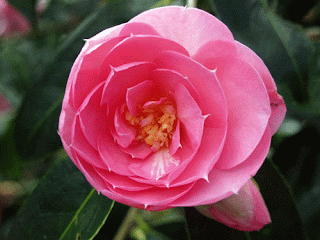Here in the far south-west, we often do not get much real winter. This means that flowers bloom early, especially camellias.
Every year I find myself taking photographs of them and sometimes they form the basis of some form of art work.
Many of them are red and others pink so they seemed like a good subject for my February quilt.
I had also been rereading a book I have on Hundertwasser .http://www.amazon.co.uk/Hundertwasser-Harry-Rand/dp/382282934X/ref=sr_1_3?s=books&ie=UTF8&qid=1331204759&sr=1-3 (Sorry that the link address is so long!) It has wonderful colour photographs and I realised that two distinctive features of his work are very bright colours and narrow 'stripes' of colour so I decided to apply these principles to a design based on camellias.
This quilt was much quicker to make than January's. I took one of the pieces of red cotton that I had dyed and made the base from that. I machine quilted it heavily with variegated threads. This approach seemed right for the scale of the piece. I made a paper mock up of the whole design and then went to my substantial collection of pieces of silk of various kinds: dupion, polyester satin, etc. It was interesting how some pieces changed colour for the worse when placed next to others but I selected a group that went together. These were bonded and appliqued over the top of strips of very fine ribbon for the stems. I am determined not to buy any new fabric for these quilts! - although that may be famous last words.
The squirls are the thing that really pay homage to Hundertwasser. I had quite a few really thick threads that I had acquired over the years plus some that I had dyed along with the red fabrics. They obviously had to be couched and I did this by hand.
I have used my new Bernina 350 in making these two quilts. I am very pleased with its ability to do free machine quilting without having to fiddle with the tension or change the base plate (as I don't have a round holed one to fit this machine). I am used to spending hours on the Artista adjusting the tension for free machine quilting! It came with both a walking foot and a free machine quilting foot and there is a No. 20 which I use a lot. The other feature that has come in handy is a switch that enables you to use the machine without a foot pedal. At the end of January I slipped very badly in the shower and pulled some ligaments/muscles (don't really know what since the doctors aren't interested!). I have been suffering badly and when, after a week, I did a couple of hours sewing with the foot pedal, my leg ended up feeling as bad as it had on the first day. So I have been using this switch. It is a bit like swopping from a manual to an automatic car as the switch does not stop automatically and you have to keep your eye on the button and press it. The trick is to slow the motor right down and to have the needle in the 'down' position. I practised first by doing a lot of piecing on a traditional quilt I am making from leftover fabric. I found it quite easy to do wavy rows of quilting with the No 20 foot and I then continued to use that for the applique. However, when it came to the satin stitch, I did have to use the foot pedal because I was having to stop and turn the work so frequently. It was all much easier than it would have been on the Artista, however.




love your first two journal quilts - fab.
ReplyDelete